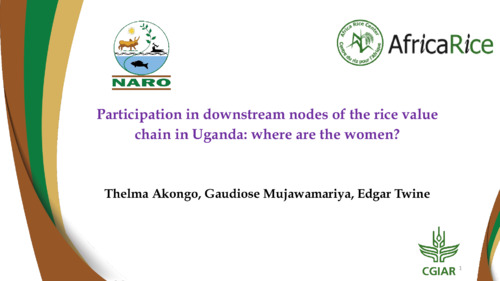Participation in downstream nodes of the rice value chain in Uganda: Where are the women?
Abstract
Evidence of women’s participation in value chains is greater on the production side, but scanty in downstream nodes, pointing to women being relegated to unprofitable activities. The consequence is suboptimal value chain performance with wide gender gaps in productivity, income, household food security, and poverty. This study sought to inform the development of gender-inclusive value chains. A qualitative investigation of the downstream nodes of the rice value chain (DS-RVC) was conducted in six districts of Eastern Uganda with 21 key informants and 93 women and 19 men in 14 focus group discussions (five mixed, nine women-only FGDs). Results confirm the limited participation of women in DS-RVC while men comprised up to 70% in all the nodes. Most women participated in wholesale and retail marketing and in lighter and unskilled activities including sweeping, cleaning, sorting, and pouring paddy into milling machines. Women’s engagement is constrained by additional reproductive and productive workloads, limited income and access to credit, and their risk-averseness toward engaging in bulk purchases. Norms are also restrictive, such as on their mobility and telephone usage and being physically unfit to operate heavy equipment. The factors favoring engagement in the DS-RVC are participation in networks, information access and skills-building, trust, respect, and cooperation— especially in joint marketing. Availability, access to and control and ownership of resources and assets are also important. Tailor-made training, subsidized processing machinery, soft loans, and improving working conditions and environment would increase women’s participation. Continuous gender sensitization for men and women would advance equitably working together.

